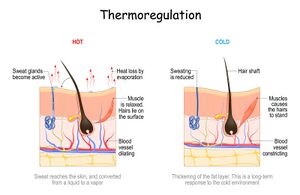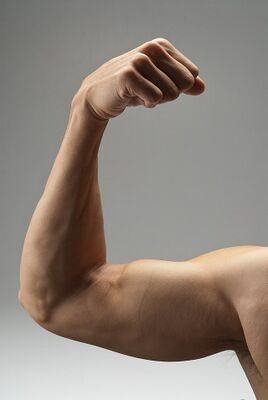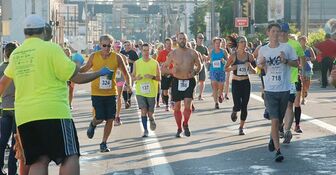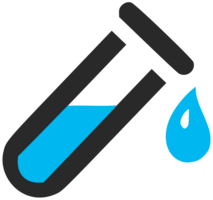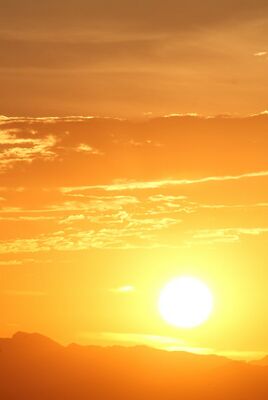Physical Activity and Perspiration
Original Editor - Kapil Narale
Top Contributors - Kapil Narale, Rishika Babburu, Kim Jackson and Uchechukwu Chukwuemeka
Introduction[edit | edit source]
Sweat is mainly a biproduct of thermoregulation, and is essential to occur in humans. Some people may like it, while others may find it disgusting. Sweat evaporation from the skin surface is also important for human temperature regulation. Despite this, there are many body-balancing functions of sweat. Similar to the kidneys, sweat glands have an important excretory function, as they eliminate excess micronutrients, metabolic waste, and toxic material from the body. Excretion of certain materials in sweat may lead to health imbalances, specifically micronutrient imbalances. [1]
In this page, we'll be exploring the different constituents, benefits, consequences, and mechanics of sweat.
Here is an introductory video before all the sweaty content: [2]
Purpose of Sweating[edit | edit source]
Thermoregulation[edit | edit source]
It is said that the main purpose of sweating is to release heat from the body for temperature regulation [1], through evaporative functions [3]. During exercise, an excess amount of heat is produced by the working muscles as a byproduct of metabolism. Also, during exercise in the outdoors, heat is transferred from the air to the body, especially when the air temperature is greater than the skin temperature. [1]
With sweating, body heat is transferred to water, which is on the surface of the skin, [1] and mainly secreted as eccrine sweat which is produced by sympathetic cholinergic receptors. [3]
The energy of sweat vaporization is 580kcal of heat per kg of evaporated sweat. [1]
As mentioned by the Heat Balance Theory, the relationship between the evaporative needs for heat balance and the maximum evaporative capacity of the environment can determine the amount of sweat produced. [1]
The main forms that the body gains heat is through exercise intensity, which can be described as metabolism, and from heat in the environment. These are the main facilitators of autonomic nervous system (ANS) activity. It should be noted that not all sweat is evaporated, and some or much of it may drip off the individual. In humid environments, with conditions of low sweat efficiency, a greater sweat rate may be required for a given amount of evaporation. [1]
Here is a brief video on thermoregulation, mentioning when the body may be too hot or too cold: [4]
Skin Health[edit | edit source]
Eccrine sweat is important in maintaining an epidermal barrier, from the release of water, natural moisturizing factors, and antimicrobial peptides, onto the skin surface. These natural moisturizing factors include amino acids, lactate, urea, Na+, and K+, which act as moisturizers for the outer layer of the stratum corneum (outer layer of skin) to stay hydrated. Most of these moisturizers are derived from eccrine sweat, and the amino acids on the skin are derived in the stratum corneum themselves. [1]
Sweating is shown to increase stratum corneum hydration, which may occur as a result of the moisture transfer from the eccrine sweat gland coil directly into the skin before surface sweating begins. [1]
An important therapeutic remedy for reversing dermatitis or dry skin conditions may be to maintain sweating on the surface of the skin. [1]
On a more sensory note, moisturizing/wetting the hands with eccrine sweat on the palmar surfaces may improve tactile sense, and strengthen grip, as a fight or flight mechanism. [1]
As mentioned above, the eccrine sweat glands produce and excrete antimicrobial peptides such as dermcidin, cathelicidin, and lactoferrin, which all act as a protective mechanism against skin infection. [1]
Physical Activity, Environment, and the Effect on Sweating[edit | edit source]
Noting that the purpose of sweating is for thermoregulation, exercise/workout, training, competition, or any activity in the heat, this will increase sweat rates. [3]
Although this is the case, sweat rates may vary between individuals. [3] It is seen that the threshold temperature for sweating can generally decrease during exercise. [5]
Athletes and workers who sweat profusely benefit from rehydrating themselves. There are two noted benefits because of this: it improves cardiovascular function, and reduces any impairments of sweating. [3]
It is seen that individuals who are heat acclimated will start to sweat earlier, and will have a higher sweat rate, while exercising. It is also noted that individuals with a larger body mass and BMI will sweat more easily compared to individuals with a smaller body mass. However, two individuals with the same body mass and same amount of heat acclimation may have differing sweat rates due to genetic variations. Physical training and heat acclimation both increase sweating at a given mean skin temperature, as physical training has a positive relationship with sweating. [3]
An interesting fact is that American football players, in their full uniform and practicing or playing in a hot and humid environment, experience one of the highest sweat rates in athletes. This can be attributed to the fact that football players have large body masses, and their uniforms retain a lot of heat. In a hot and humid environment, the average sweat loss in a football player, from 180lbs - 240lbs, can range from 4-5L/hour during a practice session. When the football players are practicing twice a day, their daily sweat amount can range form 9-12L. They must replace this lost water, otherwise may face dehydration or be at a risk for a heat injury. [3]
It can be noted that in a hot and humid environment, the performance of prolonged aerobic exercise, such as a half-marathon, full marathon, or long triathlon, is adversely effected. The hot environment can also decrease athletic performance in high-intensity anaerobic events, such as rugby, soccer, track and field, or sprinting. [3]
There are three main contributors to impaired exercise performance in the heat: [3]
- Faster muscle fatigue,
- Cardiovascular impairments, and/or
- Central Nervous System impairment.
These factors can act independently, or interact with each other, to produce decreased exercise performance. In many cases these may depend on exercise intensity and duration. [3]
It is possible to conclude that sweating occurs when the core temperature reaches a fixed amount, which would surpass a threshold temperature, which would be around 0.2oC above core temperature, for fit individuals compared to unfit individuals. [5]
In addition, concerning passive heating, it was concluded that the threshold temperature for sweating during exercise is 0.7oC lower than the threshold temperature for sweating during passive heating. As mentioned above, the exposure to thermal heat stress may be more of a factor for hidromeiosis, compared to the stress from physical activity. [5]
Sweating in Male and Female Runners[edit | edit source]
When upper body sweat rate and sweat volumes were compared between males and females, there were some interesting findings. Males and females generally showed similar sweat responses, but there were a few differences. Males had a higher sweat rate in the mid front, sides, and mid-lateral back, compared to females. Females showed a greater sweat rate in the upper arm, lateral lower back, and upper central back. In both males and females, sweating was seen to be the greatest along the spine, and greater on the back rather than the chest. [6]
Females are known to have a lower overall sweat rate, linked to a higher core and skin temperature threshold.[6]
In a study conducted, where males and females were asked to run, and their sweat output mass was measured, it is interesting to note the differing masses. Here is a detailed analysis of sweat amounts in different regions of the body in males vs. females: [6]
Males
Anterior/Front of the body -
- Slightly higher sweat amount on the chest/breast area
- Much higher sweat amount on the shoulders (over the deltoids)
- Higher sweat amount on the lateral aspect of the body/sides
- Much higher sweat amount on the mid-torso region
- Higher sweat amount at the abdominal region
Posterior/Back of the body -
- Much higher sweat amounts on the shoulders (over the deltoids)
- Much higher sweat amounts on the upper back, over the shoulder blades (scapulae)
- Much higher sweat amounts on the lateral aspects of the midback (away from the spinal column)
- Much higher sweat amount on the mid-to-lower spinal column (lower thoracic and lumbar regions)
- Same sweat amounts as females on the lower lateral aspect, above the hips
- Much higher sweat amounts at the waistline
Females
Anterior/Front of the body -
- Slightly higher sweat amount on the upper arms
Posterior/Back of the body -
- Higher sweat amounts at the spinal column of the upper back (thoracic region)
- Slightly higher sweat amounts on the upper arms (triceps area)
- Same sweat amount as males on the lower lateral aspect, above the hips
As mentioned, although males and females have the same number of sweat glands throughout the body, males have a higher sweat amount per region. [6]
It is seen that females sweat more on the upper arms (anterior and posterior), and in the middle of the upper back. Although they have lower amounts elsewhere, the presence of sweat still does exist in each area. [6]
It is noted that the different zones/regions had more of a difference between males and females, than the difference of the sexes themselves. It was also seen that the mid-central back (spine) had the highest sweat rate in both males and females, and thus the entire back had more sweat than the entire chest, as a whole. The periphery, the upper arms, had the least sweat. While males and females did not show a great difference, there was a distinction between sexes and sweat distribution between the different regions. [6]
In this present study it was seen that males were sweating 13% more than females. After the exercise test, it was seen that the males' sweat rate declined faster than the females' sweat rate. [6]
Gender/Sex and Sweating[edit | edit source]
It is important to note that, although there are known differences, it is unclear whether the differences in sweating between Men and Women are due to Physical characteristics or physiological characteristics. [5]
It is interesting to note that Men have higher sweating rates than Women. They have a higher cholinergic response, and therefore maximal sweating rates, compared to Women. However, when Men and Women with similar body mass, surface area, and metabolic heat production were compared, differences were only apparent in excess of usual environmental conditions, and metabolic heat production rate, which result in extreme evaporative needs for maintaining thermoregulation. [1] This would help explain why Women have a lower upper limit for the secretion of sweat than Men. Although Men and Women have a similar response of sweating to thermal stress, but even with an increased exposure to more severe thermal stress, Women are seen to sweat less than Men. [5]
Sweat gland density is higher in Women than Men, which can be attributed to the lower body surface area in Women, [1][6] however there are a higher number of sweat glands in Men. [6] Thus, the lower sweating rates from Women can be a result of lower output per sweat gland. [1] There may be more, but smaller, sweat droplets in Women, which also may affect evaporative efficiency. [6] In contrary, higher whole-body sweat rates in Men may be a result of higher body mass, and higher metabolic heat production from higher exercise intensities. [1]
When considering differences between Men and Women, factors such as body size, surface area to mass ratio, heat acclimation status, aerobic capacity, exercise intensity, or environmental conditions all have a greater contribution than the differences of gender and sex in deciding the exercise-heat stress related autonomic responses. These factors can affect the evaporative rate needed for thermoregulation. [1]
Menstrual cycle[edit | edit source]
It is important to note that central temperature rises during the menstrual cycle. One notable difference between Men and Women is that the threshold central temperature for sweating changes as the resting central temperature changes during the menstrual cycle in females. [5]
Some other possible factors that can affect the stimulation of the autonomic response are maturation/development, altitude/hypoxia, circadian rhythm, and/or menstrual cycle. These alterations, though, in stimulation of regional sweating from an increased body core temperature are not directly related to whole-body sweating when it comes to exercise. In regards to the menstrual cycle, regional sweating during the luteal phase is decreased at a certain body temperature, since there is a greater threshold. There aren’t any major differences in whole-body sweating during the different menstrual cycle phases. As such, for trained female athletes, exercising in the heat, the different phases of the menstrual cycle don’t have any effect on their physiology or performance. [1]
Heat and Sweating[edit | edit source]
One aspect of exercising in the heat is becoming acclimated to the hot and humid conditions. As mentioned above, heat acclimation allows sweating to begin earlier, generally at the commencement of exercise. This occurs with an increase in sweat rate as well. With sweating commencing at the beginning of exercise, there is less heat storage at the start of exercise, and there is also a lower core body temperature. Also, heat acclimation can increase the amount of sweating 3x compared to those who are not heat acclimatized. [3]
As mentioned, sweat rates increase with exercise intensity. In hot environments, sweat rates can reach 2.8L/hour. It is seen that some runners lose 8% of their body weight during a marathon, even if they are hydrating along the way. The loss of electrolytes could pose an issue as well. [3]
While exercising, excessive body heat is generally diminished from evaporation of sweat on the skin. With high humidity, water vapour pressure of air is high, thus sweating is not as effective in decreasing the body heat since evaporation cannot efficiently happen. [7]
In hot conditions it is seen that there is minimal conductive heat exchange between air and skin due to the small temperature difference between the environment and the skin. [7]
Wind speed is also an important factor. Wind can accelerate heat transfer from the skin, as the flowing air replaces the skin surface air which contains evaporating water, with more dry air, which enhances sweat evaporation. [7]
Quick moving activities such as running or cycling will not have the same effect of high heat and humidity as slower moving activities such as beach volleyball or field events. It is noted that body heat release increases with wind speed, and an increase in ambient temperature reduces air density and air resistance. [7]
The heat and light from the sun also need to be considered. Sunburns can aggravate thermal perception from exercise, which would limit thermoregulation from sweat gland responsiveness. [7]
Micronutrient Balance - NaCl[edit | edit source]
Heat acclimation results in better salt conservation, with decreased sweat. After 10 days of heat acclimation, the concentration of sweat Na+ and Cl- can range from about 30% - 60%. In fact, heat acclimation may occur after only two consecutive days of heat exposure, and sweat Na+ concentration will gradually decrease. It is seen that with heat acclimation, the rate of sweating tends to increase on the peripheral areas of the body, such as the forearms, and not so much on the chest or back. [1]
The mechanism for NaCl conservation can be due an increased responsiveness of the sweat glands to circulating aldosterone. This has an effect on Na+ reabsorption in the eccrine sweat duct by increasing Na-K-ATPase activity. For NaCl conservation to occur with heat acclimation, there needs to be a salt deficit. This helps to explain the consumption of electrolytes to maintain balance in the body. [1]
Refueling[edit | edit source]
It is uncertain whether the consumption of Na+ has an effect on sweat Na+ concentration during exercise. Sweat glands generally respond to salt deficiencies within 1-4 days. It has been shown that it may take many days or weeks for the influence of ingested Na+ to have an effect of sweat Na+ concentration. With much less Na+ ingestion, it was seen that there were no differences or there were minimal differences of sweat Na+ concentration or the rate of Na removal. It was also found that there were no differences in Na+ concentration when Na+ was ingested prior to 1.5 hours of exercise. [1]
In terms of minerals, it is seen that minimal supplementary intake of various minerals, which would already be within the body's allowable limits, have a low impact on sweat mineral loss. [1]
Since water loss of more than 2% during exercise in a hot environment can have a negative effect on endurance performance, maintaining water balance is quite important. [3]
Dehydration and Sweating[edit | edit source]
Hydration is very important before, during, and after exercise in the heat, for optimal activity performance. However, there cannot be a set amount of fluid intake or loss, as there is a variable fluid need between individuals. Fluid loss by sweating, and hydration status can be assessed by analyzing pre- and post- exercise variations in body weight, and urine color and volume. [1][3]
The consumption of salt before, during, and after activity is important to maintain sodium balance in the body. Specifically in hot environments when sweating and loss of electrolytes is high, this would help to retain and distribute the ingested water throughout the body. [7]
Sweat-induced loss of body water, or in other words, dehydration, would impair athletic performance. Dehydration resulting in a 1-2% loss of body weight is enough to inhibit exercise performance. Dehydration greater than 3% of body weight hinders physiological performance and even has the risk of a heat injury. [3]
Heat acclimation would occur with continuously practicing of the activity in the chosen/desired heat conditions. The acclimation would be met with a decrease in sweat sodium concentration, an increase in sweat rate, decrease in core body temperature, and decreased heart rate with regular exercise in the heat. Work capacity will also be increased, with the reduction of the risk of exertional heat illnesses. [7]
With heat acclimation there is a 10-12% increase in plasma volume. With the increased plasma volume, central blood volume, stroke volume, and sweating capacity are all maintained. This helps the body to store more heat with a smaller temperature gain. With heat acclimation, there is an earlier onset of sweating and a greater sweat rate. [3][5] Sweating starts to occur before heat adaptation. A greater extent of evaporative cooling can occur, which makes the sweating and the evaporative process more efficient. [3]
Contrarily, as opposed to trained and acclimatized individuals, untrained and unacclimatized individuals lose more Na+ in sweat. [3]
It is seen that dehydration may cause hidromeiosis, as mentioned above. [5]
Ageing and Sweating[edit | edit source]
Older adults are seen to have a lower sweating response than younger adults. [1] It seen that ageing does have an effect on regulating body temperature in sedentary individuals. [3] This would be a lower response per activated sweat gland from a particular pharmacological stimulus. It is seen that there is a decline in sweat response throughout adulthood, and there are regional differences within the body as the function of the sweat gland declines. However, this may be more likely due to a decrease in aerobic fitness and acclimation, as one ages. This may be due to the decrease in sensitivity of sweat gland to cholinergic stimulation. [1]
It's worth noting that UV and environmental exposures may play a role with sweat gland responsiveness as an individual ages. It is interesting to note that there isn’t a big difference between sweating rates in older and younger adults with exercise in the heat, except for peak sweating rates in hot and dry climates. [1]
A study showed that younger and older male adults showed very little difference in heat control ability. [3] Thermal tolerance, between older and younger adults, is minimally affected when factors such as fitness level, body composition, and chronic disease, are not considered. [1]
Even within healthy and physically active older individuals, heat tolerance does not seem to be drastically affected with age. However, as older adults exercise less and experience deconditioning, this may have an effect on performance (VO2 max), decreased heat tolerance, and therefore thermoregulation. [3] Therefore, it is interesting to note that there is a more apparent difference in the younger population than the older population, during exercise compared to passive exposure of heat. [5]
| Micronutrient | Concentration | Parts of the Body | Sweat Gland Mechanism |
|---|---|---|---|
| Sodium | 10-90 mmol/L | Found in many different sites such as forehead, chest, back, upper arm, but not in all individual sites, such as the foot, calf, thigh. | Initial sweat is isotonic with blood plasma – hypotonic sweat is the end result. |
| Chloride | 10-90 mmol/L | Found in many different sites such as forehead, chest, back, upper arm, but not in all individual sites, such as the foot, calf, thigh. | Initially a little hypertonic when compared to blood plasma - resulting sweat is hypotonic. |
| Potassium | 2-8 mmol/L | Sweat is closely isotonic with blood plasma. |
Here is a brief video describing the contents of sweat, how to maintain these components, and the benefits of sweating: [8]
Sweat Rate vs. Sweat Content[edit | edit source]
There is a direct correlation between sweat rate, and total sweat output from the body, and contributors to sweat composition. Whole body sweating rate is derived by the product of the density of active sweat glands and the secretion rate per gland. When someone starts sweating, the primary response is a rapid increase of sweat gland recruitment, and then a progressive increase of sweat secretion per gland. [1]
Some important aspects of thermoregulatory sweating include: [1]
- Onset (body core temperature threshold), and
- Sensitivity (slope of the relation between sweating rate and the change in body core temperature),
of the sweat response to hyperthermia.
Shifts in sweating temperature onset are central (hypothalamic), and changes in sensitivity are peripheral, at the level of the sweat gland. [1]
The Na+ and Cl- concentrations of the sweat output are determined by the rate of Na+ reabsorption in relation to Na+ secretion in the clear cells. [1]
Plasma aldosterone concentration, and/or sweat gland sensitivity to aldosterone, effects the Na-K-ATPase activity, which effects Na+ reabsorption. Resting plasma aldosterone is controlled by an individual’s long term physiological condition, which factors in heat acclimation, fitness, and diet. This also changes according to exercise and dehydration. [1]
A study found that as forearm sweating rate increased, the rate of Na+ secretion increased greater than the rate of Na+ reabsorption along the sweat duct. With this kind of sweating, stimulated from exercise activity, the concentration of Na+ sweat significantly increased. It seen that the rate of Na+ reabsorption increases with an increase in sweating rate. Despite this, the percentage of secreted Na+ reabsorbed into the duct decreased with a rise in sweat rate. The quicker the primary sweat levels along the duct, the smaller percentage of Na+ that can be reabsorbed. [1]
During exercise or heat stress, there could be a minimum threshold of sweating rate which is needed before the Na+ concentration of sweat increases, with an increase in sweating rate. It is seen that factors, such as air temperature or exercise intensity, that respond to an increase in sweating rate, will produce a higher sweat concentration of Na+ and Cl-. This may be appliable to various sites, or to the entire body. It was found that sites with a higher sweating rate of Na+ and Cl- result in a higher concentration of Na+ and Cl-. [1]
Contrarily, there are two parameters, central threshold temperature, and sensitivity, which have a major effect on determining sweat rate. These parameters help outline the effect of nonthermal factors on sweating. [5]
Bicarbonate and Lactate[edit | edit source]
The reabsorption of bicarbonate, by the sweat gland, for the acid-base balance of blood, is also an important factor. Before the sweat is released onto the skin surface, the fluid in the ductal lumen gains acidity, due to possible secretion of hydrogen ions into the sweat duct. [1]
The initial pH of sweat is about 7.1-7.4. [1]
Bicarbonate reabsorption is inversely related to sweat rate. Thus, at low sweat rates, the luminal fluid is exposed to the duct for a long time, and is further acidified, which results in a pH of about 4-5. However, at quicker flow rates, pH can remain as high as 6.9. [1]
Since lactate is produced by eccrine sweat gland metabolism, there is a direct relationship between sweat rate, and the rate of lactate excretion. The higher the sweat rate, the higher the concentration of lactate is excreted. However, due to the increased release of water content, there is an inverse relationship between sweat rate and lactate concentration. Thus, it makes sense that sweat lactate concentration decreases with an increased exercise intensity. [1]
Mechanism of Sweating[edit | edit source]
The control centre for temperature is located in the brain, and thermoreceptors are located all over the body. When body temperature increases above normal resting body temperature, the thermoreceptors send a message to the control centre in the brain. The control center responds to this by signaling a response towards heat loss, skin blood vessels dilating, and thus sweating starts to occur, as sweat glands are activated. The control center is inactivated, and sweating stops once the body returns to a normal temperature. As the sweat evaporates, heat is exchanged with the environment and is lost from the body, thus decreases skin temperature. [3]
Sweat Gland Size[edit | edit source]
The structure of sweat glands can play a role in the likelihood and amount of sweating. When the sweat glands are frequently activated, with regular exercise, there is acclimation of the sweat glands in their size and neural/hormonal response. Sweat glands, between individuals, can be of varying sizes, up to five time bigger in some individuals, than others. It is seen that the size of individual sweat glands, their response to methacholine, and secretory rate, are all directly related. Aerobic training and heat acclimation are contributors to an increase in sweat gland size and cholinergic responsiveness. [1]
Secretion[edit | edit source]
The secretion of sweat follows a Na-K-2Cl cotransport model: [1]
- Release of intracellular Ca stores and an influx of extracellular Ca into the cytoplasm is triggered by binding of acetylcholine to muscarinic receptors on the basolateral membrane of the clear cell.
- There is an efflux of KCl through Cl channels in the apical membrane and K channels in the basolateral membrane.
- This results in cell shrinkage, triggering an influx of Na, K, and Cl, from Na-K-2Cl transporters on the basolateral membrane.
- This then causes efflux of Na and K from the Na-K-ATPase and K channels on the basolateral membrane, and Cl efflux via Cl channels on the apical membrane.
The rate of Na, Cl, and bicarbonate reabsorption is flow-dependent, where higher sweat rates are directly associated with lower reabsorption rates, thus producing a higher sweat electrolyte concentration. [1]
In a study, it was proposed that the rate of secretion can be dependent on environmental factors such as humidity, wind speed, or air pressure. These environmental factors which can lead to evaporation of sweat from the skin can also facilitate sweat secretion at a given mean body temperature. [5]
Control of Eccrine Sweating & Modifiers of Eccrine Sweating[edit | edit source]
As mentioned, eccrine sweat glands primarily respond to thermal stimuli, specifically increases in core body temperature. However, skin temperature and increases in skin blood flow are also involved. [1]
Central and skin thermoreceptors sense an increase in body temperature. This information is registered by the preoptic area of the hypothalamus, to trigger the sudomotor response. Thermoreceptors in the abdominal region and surrounding muscles are also involved with controlling sweating. Thermal sweating is controlled by sympathetic cholinergic receptors. [1]
Sweat production is facilitated by the release of acetylcholine from non-myelinated sympathetic class C postganglionic nerve fibers, binding onto the muscarinic receptors on the sweat gland. Secretion of sweat can also occur due to adrenergic receptors, but this is not as dominant as cholinergic receptors. [1]
Eccrine sweat glands can also respond to exercise stimuli of a non-thermal nature which may be controlled by a feed-forward mechanism. [1]
The following chart helps outline modifiers of the control of eccrine sweating: [1]
| External and Internal Factors, and Timeframe | Timeframe | Effect on Sweating Rate and/or Composition |
|---|---|---|
| Dietary NaCl | Acute/Chronic | No effect on sweat rate with regular intake of NaCl in a short duration, within a timespan of 3 days. |
| Dietary intake of other minerals (Ca, Fe, Zn, Cu) and vitamins (ascorbic acid, thiamine) | Acute/Chronic | No effect on sweat mineral or vitamin concentrations. |
| Fluid Intake | Acute | Water ingestion results in a reflex transient increase in sweat rate, especially when in an hypohydrated state. There is no effect on sweat Na, K, Cl and lactate concentrations. |
| Dehydration | Acute | Reduced whole body, and regional, sweating rate, due to the hyperosmolarity-induced increase in threshold for the onset of sweat, and a hypovolemia-induced decrease in sweat sensitivity, with a minor effect. Similar effects are seen with sweat Na and Cl concentrations, with no effects seen on K concentrations. |
| Alcohol | Acute | There is no effect on sweating rate. However, sweat ethanol concentration increases with consumption, and increases linearly with an increase in blood alcohol concentrations. |
| Exercise Intensity | Acute | There is an increase in whole body, and regional, sweating rate with an increase in exercise intensity, since metabolism is directly related to energy expenditure. Na and Cl concentrations increase as exercise intensity increases, since the rate of Na and Cl reabsorption is flow dependent, minimal, or has no effect on sweat K concentrations. There is an inverse relationship between sweat rate and sweat lactate, and ammonia concentrations. |
| Environment | Acute | There is an increase in whole body, and regional, sweating rate with increased environmental heat stress (increased air temperature, increased solar radiation, and decreased air velocity), at a given workload. Suppression of sweating with a reduction in sweating due to a long-term exposure of humid air. There is an increase in sweat Na and Cl concentrations with an increase in ambient temperatures. |
| Altitude/Hypoxia | Acute | There is an increase in sweating. There is a reduced sweat sensitivity for regional sweat rate. |
| Clothing/Protective Equipment | Acute | There is an increase in whole body, and regional, sweat rate due to reduced evaporative, and radiant heat loss from covering the skin. The protective gear can also increase metabolic heat production. |
| Body Mass | Chronic | There is an increased whole body sweat rate in individuals with a larger body mass, due to an increased metabolic heat production at a given workload during weight-bearing exercises. Also they likely to have lower sweat efficiency. |
| Heat Acclimation | Chronic | There is an increase in whole body sweat rate. The periphery (limbs/forearm) tend to increase more than the core and center sites. This shows that there is preference towards the periphery, resulting in more distributed sweating throughout the body. There are reduced Na and Cl concentrations, and no changes in other minerals. There are ANS changes due to gland hypertrophy, increased cholinergic and aldosterone sensitivity, and a lower sweat onset threshold. |
| Aerobic Training | Chronic | There is an increase in whole body, and regional, sweat rate due to increased cholinergic sensitivity and lower sweat onset threshold. |
| Sex/Gender | Chronic | There is a higher whole body, and regional, sweat rate in Men due to greater cholinergic sensitivity and maximal sweating rate. This can occur only at high evaporative requirements for heat balance. Higher whole body sweat rate in Men can be related to a higher body mass and metabolic heat production, rather than sex/gender. There are minimal differences in sweat Na, Cl, and lactate concentrations between sex/gender. |
| Menstrual Cycle | Cyclical | There is no effect on whole body sweat rate, but there is a lower regional sweat rate at a given body core temperature during the luteal phase of menstruation. There is no effect on sweat Na, Cl, K concentrations. |
| Circadian Rhythm | Cyclical | There is an increased sweat threshold in the afternoon, between 12pm and 4pm, as opposed to early morning, between 4 am and 5:30am. |
| Race/Ethnicity | Chronic | There aren't any race or ethnicity differences in whole body, or regional, sweat rate, or sweat composition. Heat habituation, characterized by lower (activated sweat gland density and sweat gland output) and more efficient sweating (less dripping), are found in people acclimated to hot or tropical environments. |
| Maturity | Progressive Change | Lower whole body sweat rate and sweat Na concentrations are found in pre-pubertal boys compared to post-pubertal boys. |
| Ageing | Progressive Change | Reduced whole body, and regional, sweat rate related to decreased sweat gland output is associated with a reduction in aerobic fitness and heat acclimation rather than ageing. During exercise, heat stress differences are more relevant for peak sweating rate (e.g. exercise in hot dry climates). There is no impact of ageing on sweat Na concentration. |
Methods of Sweating[edit | edit source]
In addition to the methods to secrete sweat from the eccrine glands, there may be further constituents/contaminants in the sweat and/or on the skin. This can include remaining contents of the sweat duct, secretion of sebum, epidermal cells, and/or skin surface contaminants. It is seen that there can be NaCl content on the skin with or without sweating, however contents on the skin with sweating may be unnoticeable. [1]
It is seen that autonomic responses can differ between sweating from: [1]
- Pharmacological methods,
- Passive heating methods, or
- Exercise induced methods.
Evaporation of Sweat[edit | edit source]
There are three factors that control the evaporation of sweat from the skin: [3]
- Ambient conditions - air temperature and relative humidity
- The convective currents around the body
- Skins surface that is exposed to the environment
Relative humidity contributes the most to the rate of evaporative heat loss, at high environmental temperatures. Higher humidity reduces the rate of evaporation. Therefore, to have sweat evaporate in an efficient manner, it is better to be, or go towards, less humid conditions. [3]
The high relative humidity reduces the relative pressure gradient between someone's skin and the environment. With extreme high humidity the vapour pressure in the air is similar to the vapour pressure on moist skin, thus the rate of evaporation is decreased. Sweating in a hot and humid environment results in unnecessary water loss, increased body heat, and higher sweat rate. Sweating itself doesn't cool the skin, but it is the evaporation that actually cools the skin. [3]
Hidromeiosis[edit | edit source]
When it comes to hidromeiosis, the minimization of sweat secretion rate when the skin is already wet, it was noted that when there is water on the skin, either from sweating or immersion, sweat secretion is halted. In any activity or thermal sweating, it is noted that a threshold rate of sweating must be reached for hidromeiosis to begin. Hidromeiosis does not seem to be an adaptive process, since as sweating begins to cease, the temperature in certain areas of the body may begin to rise. It is seen, too, that dehydration may increase hidromeiosis. In addition, the exposure to thermal heat stress may be more of a factor for hidromeiosis, compared to the stress from physical activity. Hidromeiosis usually commences after 1-2 hours of intense physical activity, and as such there is a threshold sweat rate, at which hidromeiosis ceases. [5]
Hidromeiosis is seen to only affect sweat rate after the skin becomes fully wet. Also, the rate at which sweat rate decreases is directly related to the sweat rate when hidromeisos begins. It is important to note that heat adaptation (in the summer) or adaptation to the cold (in the winter) affects the threshold of when hidromeiosis starts. In general, it is possible that hidromeiosis may be the cause of the cessation of sweating in humid environments, as opposed to dry environments. [5]
For an extension on the topic of sweat, check out these pages:
Here is a quick, very informative TedEd video on sweat, and its various components: [9]
References[edit | edit source]
- ↑ 1.00 1.01 1.02 1.03 1.04 1.05 1.06 1.07 1.08 1.09 1.10 1.11 1.12 1.13 1.14 1.15 1.16 1.17 1.18 1.19 1.20 1.21 1.22 1.23 1.24 1.25 1.26 1.27 1.28 1.29 1.30 1.31 1.32 1.33 1.34 1.35 1.36 1.37 1.38 1.39 1.40 1.41 1.42 1.43 1.44 1.45 1.46 1.47 1.48 1.49 1.50 Baker Lindsay B. Physiology of sweat gland function: The roles of sweating and sweat composition in human health. Temperature. 2019:6(3):211-259.
- ↑ AniMed. How Sweat Glands Work Animation - Why Are You Sweating? What is Sweat Made of | Mechanism Video. Available from: https://www.youtube.com/watch?v=ByGGlZDLeSA&ab_channel=AniMed (accessed 24 June 2022).
- ↑ 3.00 3.01 3.02 3.03 3.04 3.05 3.06 3.07 3.08 3.09 3.10 3.11 3.12 3.13 3.14 3.15 3.16 3.17 3.18 3.19 3.20 3.21 3.22 3.23 3.24 Powers, Scott K. Howley, Edward T. editors. Exercise Physiology - Theory and Application to Exercise and Performance. 10th Ed. New York: McGraw-Hill Education. 2018.
- ↑ FuseSchool - Global Education. Temperature Regulation of The Human Body | Physiology | Biology | FuseSchool. Available from: https://www.youtube.com/watch?v=vJhsyS4lTW0&ab_channel=FuseSchool-GlobalEducation (accessed 24 June 2022).
- ↑ 5.00 5.01 5.02 5.03 5.04 5.05 5.06 5.07 5.08 5.09 5.10 5.11 5.12 Wissler Eugene H. Sweating. Human Temperature Control - A Quantitative Approach. Berlin. Springer. 2018. 197-233.
- ↑ 6.0 6.1 6.2 6.3 6.4 6.5 6.6 6.7 6.8 6.9 Havenith George, Fogarty Alison, Bartlett Rebecca, Smith Caroline J, Ventenat Vincent. Male and female upper body sweat distribution during running measured with technical absorbents. European Journal of Applied Physiology. 2008:104:245-255.
- ↑ 7.0 7.1 7.2 7.3 7.4 7.5 7.6 Bergeron MF, Bahr R, Bartsch P, Bourdon L, Calbet JAL, Carlsen KH, Castagna O, Gonazalez-Alonso J, Lundby C, Maughan RJ, Millet G, Mountjoy M, Racinais S, Rasmussen P, Singh DG, Subudhi AW, Young AJ, Soligard T, Engebretsen L. International Olympic Committee consensus statement on thermoregulatory and altitude challenges for high-level athletes. British Journal of Sports Medicine. 2012:46:770-779
- ↑ Dr. Eric Berg DC. The Benefits of Sweating. Available from: https://www.youtube.com/watch?v=PrUui7S58uU&ab_channel=Dr.EricBergDC (accessed 24 June 2022).
- ↑ Ted-Ed. Why do we sweat? - John Murnan. Available from: https://www.youtube.com/watch?v=fctH_1NuqCQ&ab_channel=TED-Ed (accessed 24 June 2022).
